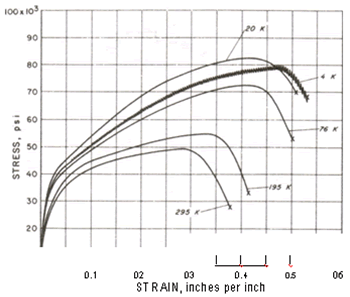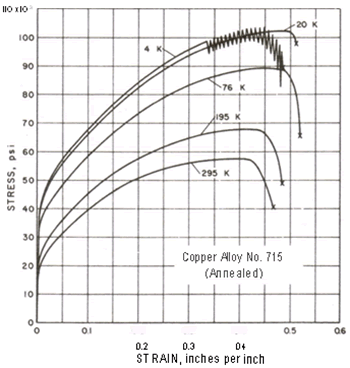Copper and copper alloys were the first metals used in the fabrication of low-temperature equipment for the liquefaction and storage of cryogenic fluids. Copper and many copper alloys retain ductility at low temperatures. Their unusual properties of retaining ductility at low temperatures and exhibiting good thermal conductivity is advantageous for heat exchangers and other components in cryogenic plants and in low-temperature processing and storage equipment.
The table below shows that 90-10 and 70-30 Cu-Ni alloys become stronger while still retaining good ductility as temperatures decline. They also retain excellent impact properties.
| Alloy | Test temperature, °K | Elastic properties | Plastic Properties | ||||||
|---|---|---|---|---|---|---|---|---|---|
| Uniaxial | Triaxial | ||||||||
| No. | Name And treat-ment | Youngs Modulus 106psi (5%) | Tensile Strength psi | Yield Strength psi | Elongation % in 4D | Reduction in Area % | Notch tensile Strength (KT=5.0) psi | Impact Charpy Energy Absorbed, ft-lb | |
| 706 | 90-10 Cu-Ni, (ann-ealed) |
295 | 17.7 | 49,600 | 21,400 | 37 | 79 | 65,000 | 114 |
| 195 | 54,700 | 24,700 | 42 | 77 | 73,100 | 113 | |||
| 76 | 19.5 | 72,000 | 24,800 | 50 | 77 | 87,200 | 115 | ||
| 20 | 82,500 | 30,200 | 50 | 73 | 96,800 | 116 | |||
| 4 | 20.5 | 80,600 | 24,900 | 53 | 73 | 100,000 | |||
| 715 | 70-30 Cu-Ni, (ann-ealed) |
295 | 22.0 | 57,800 | 18,700 | 47 | 68 | 79,400 | 115 |
| 195 | 68,000 | 22,200 | 48 | 70 | 90,500 | 114 | |||
| 76 | 23.0 | 89,800 | 31,600 | 52 | 70 | 112,900 | 114 | ||
| 20 | 103,100 | 38,100 | 51 | 66 | 127,600 | 114 | |||
| 4 | 23.2 | 104,600 | 40,100 | 48 | 65 | 130,500 | |||
|
Taken from CDA Application Data Sheet 144/8R. |
|||||||||
Stress-strain diagrams for 90-10 and 70-30 copper-nickels are illustrated below.
 Stress-strain diagram for Copper Alloy No. 706 (Annealed)
Stress-strain diagram for Copper Alloy No. 706 (Annealed) Stress-strain diagram for Copper Alloy No. 715 (Annealed)
Stress-strain diagram for Copper Alloy No. 715 (Annealed)References
- Low Temperature Properties of Copper and Copper Alloys, Application Data Sheet 104/5, CDA, .
- Mechanical Properties of Copper and Copper Alloys at Low Temperatures, Application Data Sheet 144/8 R, CDA, .
